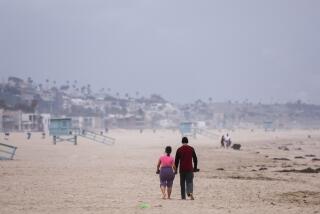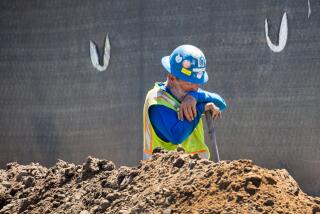‘June Gloom’ Obscures July : Weather: Lingering cloudiness has stifled summer crowds along coastline.
- Share via
Thanks to the persistent low clouds that have blanketed Southern California for most of the past few weeks, 1993 may be remembered as the year that summer almost didn’t happen.
According to meteorologists, a weather pattern traditionally associated with June--the fabled “June Gloom”--has lingered through July, often shrouding the sun until the afternoon and resulting in average high temperatures that are 10 degrees below normal.
“What’s going on is usually we get a lot of low clouds in June and less and less in July,” said National Weather Service forecaster Ivory Small. “This year, it just keeps on going. The low clouds just won’t go away.”
As a result, tourist-dependent businesses in Orange County and throughout the Southland are suffering through the abridged summer season.
“We’re still waiting for summer,” said a laughing Ralph Rodheim, president of the Balboa Island Improvement Assn., whose boat-rental business is down about 20% from what he expects for July.
“July has been off. . . . Now why is it off? I think the weather plays the biggest role,” he said. “It’s not sweltering hot inland, it’s overcast . . . people don’t think of the beach as a first option.”
The weather, said Vesta Long, operator of a video arcade near the Huntington Beach Pier, “has killed business. It really has. . . . We haven’t had a summer yet. . . . It’s sad.”
People from inland hear weather reports calling for clouds the next morning, and don’t come to the beach, Long said, even though the sun may be shining by lunchtime.
The gray mood is palpable along the Orange County coastline, even with businesses unrelated to surf and sand.
“On a gloomy day, there’s less traffic on the street,” said Nathan Cohen of Seal Beach’s Bookstore on Main Street, “although I don’t think it affects my business.”
The cloudy weather “does create some form of a depression,” Cohen said. “I think that goes with the gloomy weather.”
Although business has not been hurt at the surf wear shop in Huntington Beach where he works, Vince Salazar said he noticed that the weather has made some of his friends “irritable, less cheery. We’re expecting a summer and it hasn’t come yet.”
The unusual weather pattern is the product of a weaker than usual high-pressure system off the Northwest that is allowing the jet stream to dip south.
On the bright side, the dreary weather has reduced the crowds at some local beaches and public swimming pools and improved the air quality.
Weekday attendance at Huntington State Beach has declined by about 70% compared to last year, said lifeguard supervisor Finn McClafferty. The smaller crowds also mean ocean rescues have decreased by about 70%.
Bundled in a jacket against the afternoon winds, Huntington Beach lifeguard Jeff Koller said that “the June gloom has been stretching until 2 or 3 o’clock most afternoons.” Because the gray days mean people are “less prone to go into the water,” Koller said, lifeguards are a little relaxed in the mornings.
Newport Beach police report far less traffic on the usually overcrowded Balboa Peninsula, and lifeguards in that city say the beach parking lots have not been as full as usual.
“If it’s not really hot in the Inland Empire, they’re not going to come down,” Marine Safety Lt. Jim Turner said of the typical summer beach crowds. “The first part of July had large crowds, big surf and sunny days, (but) since then we’ve had a lot of marine layer . . . and the people don’t tend to come down.
“We’re not even getting the morning burn-off, we’re getting the mid-afternoon burn-off.”
Likewise, attendance at Los Angeles city pools has dropped 25% this month compared to last year, said an official with the Los Angeles Department of Recreation and Parks.
The persistent marine layer has also caused a reduction in smog levels. So far this year, nine first-stage smog alerts have been recorded throughout the Los Angeles Basin, according to the South Coast Air Quality Management District. Last year at this time, there had been 17.
Normally, thermal inversions--a layer of warm air on top of cool marine air--clamp a lid 1,000 to 1,500 feet above sea level around the Los Angeles Basin, trapping the pollution. Emissions interacting with sunlight throughout the day make things worse.
This year, said Joe Cassmassi, senior meteorologist with the AQMD, instead of a high-pressure system that fosters an inversion, there has been an upper level, low-pressure system that promotes the dilution of pollutants. And the low clouds have prevented the pollutants from reacting with sunlight and causing more smog.
Times Staff Writer Jodi Wilgoren contributed to this report.
More to Read
Sign up for Essential California
The most important California stories and recommendations in your inbox every morning.
You may occasionally receive promotional content from the Los Angeles Times.













